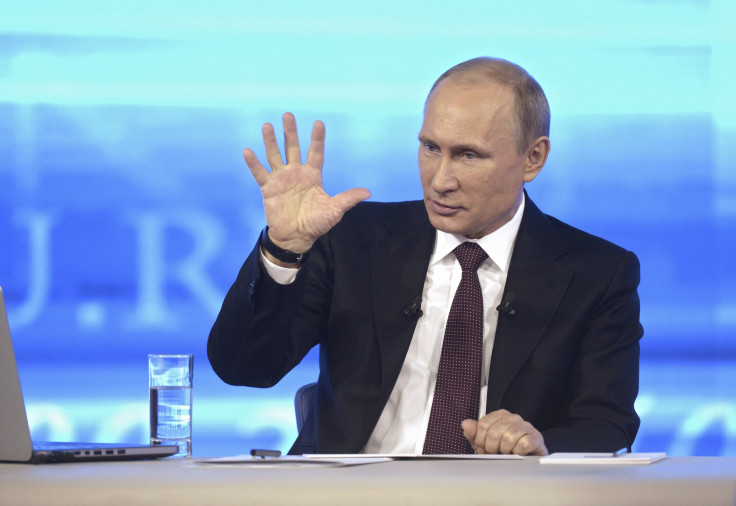How The Current Chaos In East Ukraine May Be Part Of Putin’s Plan

Ukraine’s interim government reacted Friday to Russian troops positioned along its borders with a threat to “blockade” the pro-Russian militants in the eastern town of Slovyansk. Any attempt by Russian troops to cross the border will be treated as an invasion, the Kiev government warned.
“Attempts at military conflict in Ukraine will lead to a military conflict in Europe,” Arseniy Yatsenyuk, Ukraine’s interim prime minister, told the cabinet in remarks broadcast live. “The world has not yet forgotten World War II, but Russia already wants to start World War III.”
Russia’s latest actions are reminiscent of its annexation of the Crimean peninsula in March. Russian President Vladimir Putin had ordered military exercises along its borders, placed jets on standby, and had unmarked soldiers to take control of key airports and surround Ukrainian military bases in the region. Putin had previously denied the existence of the unmarked soldiers, but he later confirmed they helped lay the groundwork for the referendum that led Crimea to join Russia.
Similar actions have been taken in eastern Ukraine, which begs the question whether Putin is priming for another land grab.
Russia has mobilized its army along the border, and there have been reports of unmarked soldiers in the region that bear a strong resemblance to those in Crimea. Serhiy Pashynskyi, Ukraine’s acting Head of the Presidential Administration, said Russian troops included “400 tanks, armored vehicles and rocket launchers.”
Despite the agreement signed on April 17 between Russia, Ukraine, the U.S. and the European Union that asked for illegal armed groups in eastern Ukraine to return seized property and leave public places, pro-Russian militants continue to be active in eastern cities such as Mariupol, Slovyansk and Donetsk. Journalists and local politicians have been captured, tortured and in some instances, killed. On Friday, seven monitors from the Organization for Security and Co-operation in Europe were taken hostage by pro-Russian separatists and held near Slovyansk, Sky News reported.
Janine Davidson, a senior fellow at the American Council on Foreign Relations, said Putin may be embracing the current chaos in Ukraine as a pretext to invade the country under the guise of a peacekeeping mission.
“[Putin] wants it to look spontaneous,” Davidson told CTV News. “If he simply rolled in tanks, it would be too sloppy, and draw unwanted attention. He would rather let the situation get unstable from the inside, because the more he does, the more he looks like a peacekeeper.”
Throughout the conflict, Putin has made remarks that suggest he may be employing the same strategy he used in Crimea -- leaning on Russia’s history to justify its current actions.
In one instance he refers to ethnic Russians in Ukraine as belonging to a “single people” that “has been an object of international politics for centuries."
Putin has also been cited calling the eastern portion of Ukraine with a word, "Novorossiya" or "New Russia," that appeared in the 18th century, during a period of Russian expansion under the Tsarist empire. During a question and answer session, Putin explained the reference: "I would like to remind you that what was called Novorossiya back in the Tsarist days -- Kharkov, Lugansk, Donetsk, Kherson, Nikolayev and Odessa -- were not part of Ukraine back then," Putin said. "The center of that territory was Novorossiysk, so the region is called Novorossiya. Russia lost these territories for various reasons, but the people remained."
Putin has used history to explain his actions in the past. When he signed an agreement in March on the “reunification” of Crimea with Russia he said, "To understand the reason behind such a choice," Putin said in a speech to parliament, "It is enough to know the history of Crimea and what Russia and Crimea have always meant for each other." That is, Crimea should have not been included in the 1954 agreement where the region ended up as part of Ukraine.
Keith Darden, a professor at American University, sees some differences with the current conflict compared to what happened in Crimea.
"Whereas Crimea he saw as a strategic asset that was important to pull away, the strategic value of the south and the east of Ukraine is within Ukraine as a bulwark against Kiev turning further to the West, joining NATO, engaging more actively with the European Union. So he wants to keep them in Ukraine but more powerful," Darden told Voices of America.
On a call with European leaders on Friday, President Barack Obama pointed to the “concerning rhetoric and military exercises on Ukraine’s border” as signs that Russia is escalating the situation in Ukraine rather than abiding by the international agreement designed to stifle the conflict.
Obama says targeted economic sanctions that could affect Russia’s broad economy are being discussed if Moscow invades eastern Ukraine. His comments affirm that these may not deter Putin and will only be implemented if there is a full military invasion since they could have reverberations for U.S. and European allies that do business with Russia.
On Friday, Russian foreign minister, Sergei Lavrov, apparently offered a solution to solve the ongoing crisis: If the interim government clears out the nationalist protest camp in Kiev, then the pro-Russian separatists will lay down their arms.
Western officials were skeptical about the offer, citing the stipulations made in the Geneva agreement and that the protest camp erected in February during the uprising that toppled Russian-backed president, Viktor Yanukovych, has already been disassembled. According to a team from the Organization for Security and Co-operation in Europe, there is “ongoing clearing of barricades” in Kiev’s Independence Square. "The situation in the capital city was calm," the report added.
© Copyright IBTimes 2024. All rights reserved.






















